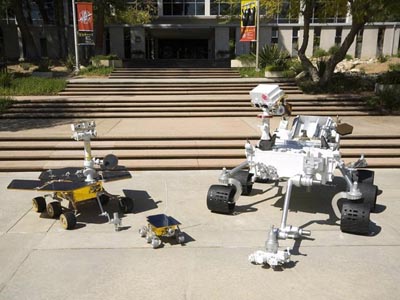The payload fairing containing the Mars Science Laboratory rolls out of the Payload Hazardous Servicing Facility last November. Photo by NASA
Want to learn more about the much-anticipated landing of the Mars Science Laboratory’s (MSL) Curiosity rover, which is set to alight on Mars on 5/6 August? NASA has sent the rover to the red planet on a mission that has cost US$2.5bn. And the aim? To see if life has ever existed, or could exist, on Mars.
Well, tomorrow NASA will be hosting a series of social media events to connect up seven of its centres in the US to give people more insights about the rover mission, its most expensive one yet to head to Mars.
The Curiosity rover, which set off on 26 November 2011 towards Mars for an August landing date at Gale Crater, is using the stars to navigate its flight path.
Depending on where in the world you are, the spacecraft’s scheduled arrival on Mars is 5 August (PDT) or 6 August, (Universal Time and EDT).
Martian atmosphere
Once on Mars, the car-sized Curiosity will be investigating whether the selected region on Mars inside Gale Crater has offered environmental conditions that could have been favourable for supporting microbial life, as well as potentially offering clues about whether life ever existed on the planet.
But back to tomorrow’s social media gathering. The space agency holds what it calls NASA Socials to allow its social media following to virtually connect from time to time. The in-person virtual meetings are held with people who engage with the agency through Twitter, Facebook, Google+ and other social networks.

Technologists at Lockheed Martin in Denver, Colorado, work on the Curiosity rover’s aeroshell in 2008. This shield has been built to protect the rover during the descent to Mars. Image by NASA’s Curiosity Mars Rover album on Facebook
NASA is hosting tomorrow’s Social to reveal more about the landing of the Curiosity rover on Mars.
Events will be held simultaneously at the Ames Research Center in Moffett Field, California; Glenn Research Center in Cleveland, Ohio; Goddard Space Flight Center in Greenbelt, Maryland.; Jet Propulsion Laboratory (JPL) in Pasadena, California.; Johnson Space Center in Houston, Texas; Kennedy Space Center in Cape Canaveral, Florida; and Langley Research Center in Hampton, Virginia.
The Kennedy Space Center will also be celebrating its 50th anniversary during this NASA Social.
Tuning in
The space agency said that people who wish to tune in to the Social online tomorrow will be able to do so by visiting a NASA dashboard.
From 12.30-2.30pm EDT, every centre will be connected with the Jet Propulsion Laboratory (JPL), which is managing the Curiosity mission.
NASA Social participants at each centre will have the opportunity to ask questions of the JPL science and engineering teams during the simulcast.
People can also follow the Curiosity mission in the lead-up to the landing via Facebook and Twitter.

The NASA rover family. Spirit/Opportunity (left), Sojourner (centre), and Curiosity (right). Sojourner is about the size of a microwave oven. Image by NASA’s Curiosity Mars Rover album on Facebook
Features of the NASA rover:
- Curiosity is twice as long and five times as heavy as earlier Mars rovers.
- A mast extending to 2.1 metres above ground will provide height for cameras and a laser-firing instrument to study targets from a distance.
- Instruments on a 2.1-metre long arm will study targets up close. Analytical instruments inside the rover will determine the composition of rock and soil samples acquired with the arm’s powdering drill and scoop.
- Other instruments will characterise the environment, including the weather and natural radiation that will affect future human missions.
- The rover will use a laser to look inside rocks and release their gasses so its spectrometer can analyse and send the data back to Earth.